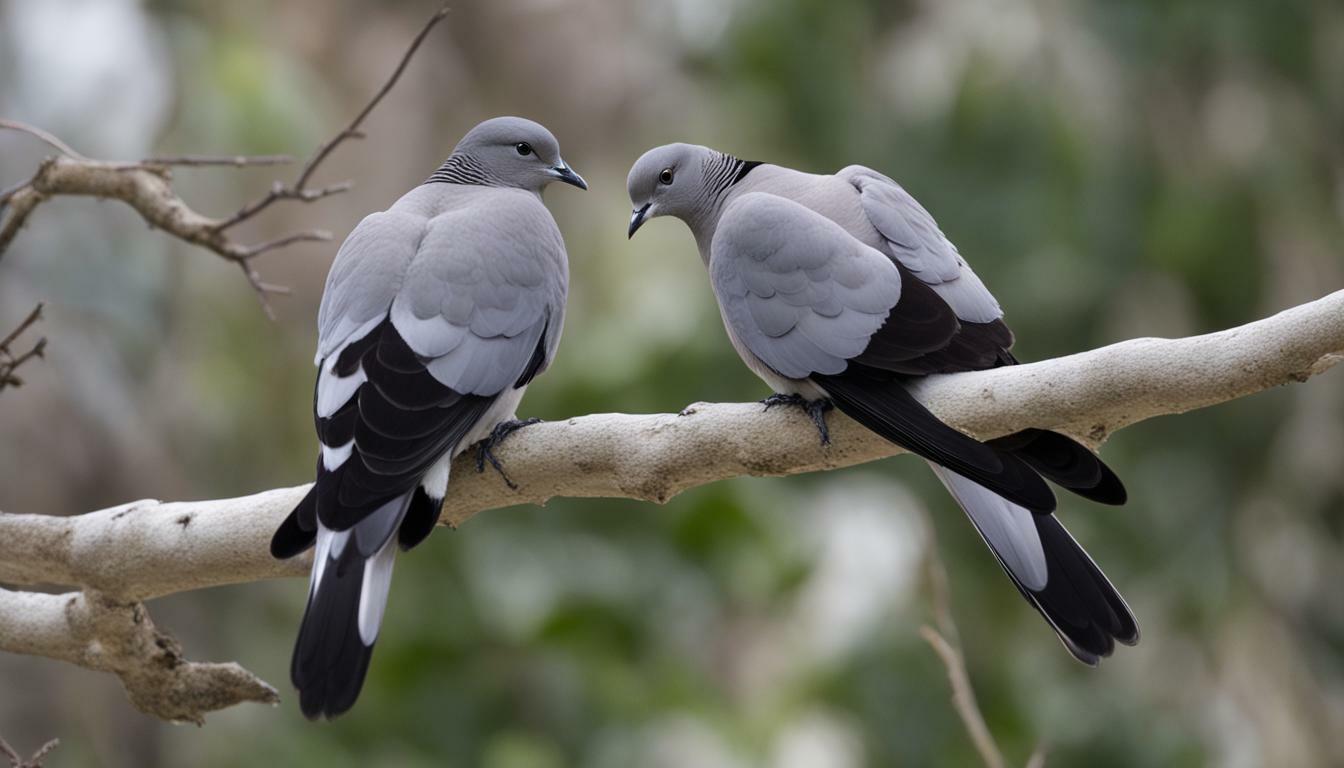When it comes to identifying dove species, two of the most commonly observed varieties are the Mourning and White-Winged Doves. While the two may look similar at a glance, there are essential differences that set them apart.
In this section, we will highlight the key physical, behavioral, and environmental characteristics that distinguish these two fascinating birds.
Key Takeaways:
- The Mourning and White-Winged Doves are two common dove species.
- Despite their similarities, they have distinguishing features that set them apart.
- By exploring their unique attributes, people can identify these birds and appreciate their beauty.
Dove Identification: Unique Features and Characteristics
At first glance, Mourning and White-Winged Doves may seem virtually identical. However, upon closer inspection, several distinctive physical characteristics set the two species apart.
| Dove Species | Size | Coloration | Unique Features |
|---|---|---|---|
| Mourning Dove | 9-12 inches | Light gray-brown head, neck, and wings, with darker speckles on the wings | Long, tapered tail; small, pointed bill |
| White-Winged Dove | 11-12 inches | Blue-gray head, neck, and wings, with distinctive white wing patches | Short, rounded tail; chunky build; red eyes |
Mourning Doves are slightly smaller than White-Winged Doves, with an average length of 9-12 inches. They have a light gray-brown head, neck, and wings, and their wings are speckled with darker markings. They also have a long, tapered tail and a small, pointed bill.
White-Winged Doves, on the other hand, are larger, averaging around 11-12 inches in length. These doves have a blue-gray head, neck, and wings, with distinctive white wing patches that are visible in flight. They also have a short, rounded tail, a chunky build, and striking red eyes.
In addition, Mourning Doves are known for their soft, mournful cooing calls, while White-Winged Doves have a more distinctive cooing pattern with three distinct syllables.
By examining these unique features and characteristics, it is possible to distinguish between these two beautiful dove species with ease.
Behavior and Migratory Patterns
Doves are known for their gentle and peaceful demeanor, but each species has its own unique behaviors and migration patterns. Understanding the biology of Mourning and White-Winged Doves can help birdwatchers better appreciate these beautiful creatures.
Mourning Dove Behavior
Mourning Doves are commonly found in open habitats such as fields, roadsides, and backyards. They are often seen foraging on the ground, feeding on seeds and insects. Their soft cooing calls are a familiar sound in many urban and suburban areas. During breeding season, males perform a graceful display flight to attract females.
Mourning Doves are generally non-migratory, but some populations do make seasonal movements in response to food availability and weather conditions. They are found throughout North and Central America, from southern Canada to Panama.
White-Winged Dove Behavior
White-Winged Doves are larger and more colorful than Mourning Doves, with distinctive white patches on their wings. They prefer habitats with dense vegetation, such as woodlands and brushy areas, and are often found in agricultural fields feeding on grains and fruits.
White-Winged Doves have a unique courtship display, where males perch on a high branch and coo while fanning their tails and puffing out their chests. Like Mourning Doves, they are generally non-migratory but may make small movements in response to food availability and weather conditions. They are found in the southwestern United States, Mexico, and Central America.
Migratory Patterns
Migratory patterns differ between species and populations. Some Mourning Doves have been known to travel up to 1,000 miles during migration, while others may not migrate at all. White-Winged Doves in Texas have been observed moving back and forth between urban and rural areas in response to seasonal changes in food availability.
Understanding the behavior and migration patterns of these fascinating birds can make birdwatching a truly enriching experience.
Habitat and Range
Mourning Doves are found in a wide range of habitats, including woodlands, grasslands, deserts, and urban areas. They prefer open areas with scattered trees and shrubs, but can also be found in agricultural fields and along roadsides. In the winter, they may move south to warmer regions but return to their breeding grounds in the spring.
White-Winged Doves, on the other hand, are more commonly found in arid and semi-arid habitats, such as deserts and thorn scrub. They also inhabit urban areas, such as parks and gardens, and can be found along watercourses. They are typically found in the southwestern United States and Mexico.
Vocalizations and Communication
Doves are known for their soothing cooing sounds, which can often be heard in the early morning or evening hours. Mourning Doves have a distinct call, which sounds like ‘coo-ahh-coo-coo-coo’. This call is often used during courtship displays, and when defending their territory.
White-Winged Doves also have a unique call, which is louder and more complex in comparison to the Mourning Dove. Their call is often described as a ‘who-cooks-for-you’ sound. These calls are used by males during the breeding season to attract females, and by both sexes to establish their territory.
In addition to their calls, doves also use a variety of visual signals to communicate, including body language and posturing. For example, when threatened, a dove will often puff up its feathers to make itself appear larger, or lower its head to protect its vital areas.
Dove behavior can also vary depending on the season. During the winter months, Mourning Doves often form large flocks, while White-Winged Doves tend to be more solitary. As the breeding season approaches, males of both species become more vocal and aggressive in their efforts to attract mates.
Identifying doves by their calls and behavior can be a fun and rewarding experience for birdwatchers and nature enthusiasts. By observing their unique vocalizations and social interactions, you can gain a deeper understanding and appreciation of these beautiful birds.
Conclusion
As we come to the end of our exploration of the Difference Between Mourning and White-Winged Doves, we hope you have gained a deeper appreciation for these unique bird species. While both doves have similar physical attributes, including small size and delicate coloration, the key differences lie in their distinct features, behaviors, and habitats.
Mourning Doves are known for their melancholy calls and distinct wing whistles, while White-Winged Doves have a distinctive white stripe on their wings. Additionally, Mourning Doves tend to prefer open habitats, while White-Winged Doves are commonly found in desert areas.
Despite these differences, both Mourning and White-Winged Doves play critical roles in their ecosystems, providing essential services such as seed dispersal and pollination. Next time you spot one of these birds, take a moment to appreciate their unique beauty and importance.
 Skip to main content
Skip to main content


